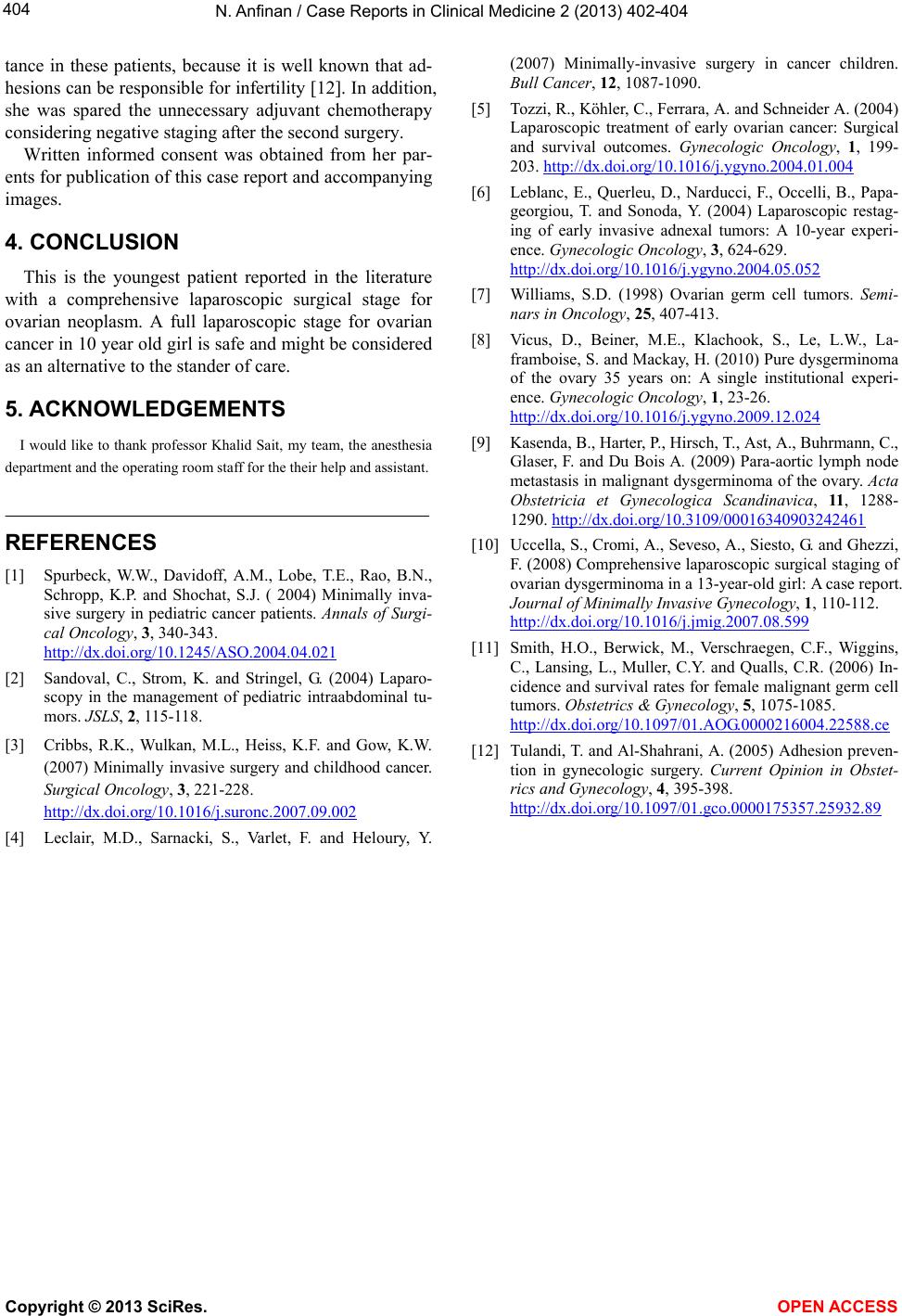
N. Anfinan / Case Reports in Clinical Medicine 2 (2013) 402-40 4
Copyright © 2013 SciRes. OPEN ACCESS
404
tance in these patients, because it is well known that ad-
hesions can be responsible for infertility [12]. In addition ,
she was spared the unnecessary adjuvant chemotherapy
considering negative staging after the second su rgery.
Written informed consent was obtained from her par-
ents for publication of this case report and acco mpanying
images.
4. CONCLUSION
This is the youngest patient reported in the literature
with a comprehensive laparoscopic surgical stage for
ovarian neoplasm. A full laparoscopic stage for ovarian
cancer in 10 year old girl is safe and might be considered
as an alternative to the stander of care.
5. ACKNOWLEDGEMENTS
I would like to thank professor Khalid Sait, my team, the anesthesia
department and t h e o p e rating room staff for the their help and assistant.
REFERENCES
[1] Spurbeck, W.W., Davidoff, A.M., Lobe, T.E., Rao, B.N.,
Schropp, K.P. and Shochat, S.J. ( 2004) Minimally inva-
sive surgery in pediatric ca ncer patients. Annals of Surgi-
cal Oncology, 3, 340-343.
http://dx.doi.org/10.1245/ASO.2004.04.021
[2] Sandoval, C., Strom, K. and Stringel, G. (2004) Laparo-
scopy in the management of pediatric intraabdominal tu-
mors. JSLS, 2, 115-118.
[3] Cribbs, R.K., Wulkan, M.L., Heiss, K.F. and Gow, K.W.
(2007) Minimally invasive surgery and childhood cancer.
Surgical Oncology, 3, 221-228.
http://dx.doi.org/10.1016/j.suronc.2007.09.002
[4] Leclair, M.D., Sarnacki, S., Varlet, F. and Heloury, Y.
(2007) Minimally-invasive surgery in cancer children.
Bull Cancer, 12, 1087-1090.
[5] Tozzi, R., Köhler, C., Ferrara, A. and Schneider A. (2004)
Laparoscopic treatment of early ovarian cancer: Surgical
and survival outcomes. Gynecologic Oncology, 1, 199-
203. http://dx.doi.org/10.1016/j.ygyno.2004.01.004
[6] Leblanc, E., Querleu, D., Narducci, F., Occelli, B., Papa-
georgiou, T. and Sonoda, Y. (2004) Laparoscopic restag-
ing of early invasive adnexal tumors: A 10-year experi-
ence. Gynecologic Oncology, 3, 624-629.
http://dx.doi.org/10.1016/j.ygyno.2004.05.052
[7] Williams, S.D. (1998) Ovarian germ cell tumors. Semi-
nars in Oncology, 25, 407-413.
[8] Vicus, D., Beiner, M.E., Klachook, S., Le, L.W., La-
framboise, S. and Mackay, H. (2010) Pure dysgerminoma
of the ovary 35 years on: A single institutional experi-
ence. Gynecologic Oncology, 1, 23- 2 6.
http://dx.doi.org/10.1016/j.ygyno.2009.12.024
[9] Kasenda, B., Harte r, P., Hirsch , T. , Ast, A., Buhrmann, C.,
Glaser, F. and Du Bois A. (2009) Para-aortic lymph node
metastasis in malignant dysgerminoma of the ovary. Acta
Obstetricia et Gynecologica Scandinavica, 11, 1288-
1290. http://dx.doi.org/10.3109/00016340903242461
[10] Uccella, S., Cromi, A., Seveso, A., Siesto, G. and Ghezzi,
F. (2008) Comprehensive laparoscopic surgical staging of
ovarian dysgerminoma in a 13-year-old girl: A case report.
Journal of Minimally Invasive Gynecology, 1, 110-112.
http://dx.doi.org/10.1016/j.jmig.2007.08.599
[11] Smith, H.O., Berwick, M., Verschraegen, C.F., Wiggins,
C., Lansing, L., Muller, C.Y. and Qualls, C.R. (2006) In-
cidence and survival rates for female malignant germ cell
tumors. Obstetrics & Gynecology, 5, 1075-1085.
http://dx.doi.org/10.1097/01.AOG.0000216004.22588.ce
[12] Tulandi, T. and Al-Shahrani, A. (2005) Adhesion preven-
tion in gynecologic surgery. Current Opinion in Obstet-
rics and Gynecology, 4, 395-398.
http://dx.doi.org/10.1097/01.gco.0000175357.25932.89